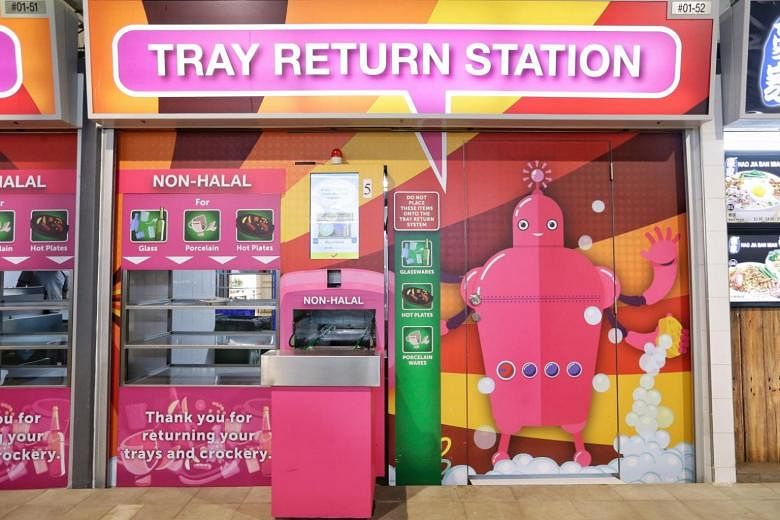A system of charging customers a deposit that will be forfeited if they do not return food trays may be rolled out at up to 25 hawker centres in the coming years despite mixed reviews over its effectiveness.
It is part of a government push to boost productivity in hawker centres amid tightening manpower constraints, attract younger Singaporeans to enter the profession and also promote more gracious behaviour among food patrons.
An automated tray return system has been implemented at the Marsiling Mall Hawker Centre and Bukit Merah Hawker Centre since last December, where stallholders charge customers 50 cents and $1 per tray taken, respectively.
Such a system could also be implemented in another 23 existing hawker centres managed by the National Environmental Agency (NEA) as part of its efforts to make hawker centres more productive, which also include centralised dishwashing services. There are 114 hawker centres and markets managed by the NEA or through NEA-appointed managing agents.
Visiting the Marsiling Mall Hawker Centre yesterday to view the two initiatives, Dr Amy Khor, Senior Minister of State for the Environment and Water Resources, said they would help boost the overall business of hawker centres and "reduce the workload on the hawkers so they can concentrate on food preparation and cooking, which is their core business activity".
"(It also) ensures that they will continue to have a steady supply of clean cutlery and crockery even during peak hours," added Dr Khor.
The two initiatives are part of the recommendations submitted last year by the Hawker Centre 3.0 Committee to reduce hawkers' workload and tackle manpower challenges.
Tray return systems involving a deposit is not new here, with the Timbre Group implementing a similar system at its food hall Timbre+ in one-north and at the Yishun Park Hawker Centre. Other attempts to boost the average tray return rate of about 20 per cent to 30 per cent here included a reward points scheme.
But hawker centre patrons are divided over the tray return system.
Marketing manager Erica Li, 34, does not find it a hassle to return trays. "I believe you should clean up after yourself," she said.
But childcare teacher Chua Kim Choo, 65, said that even though the initiative helps to keep the tables clean, it can be tough on older people who have difficulty walking to return their trays after their meal.
"There should be more tray return areas around the hawker centre for such customers," she added.
Public Hygiene Council chairman Edward D'Silva said giving disincentives to promote tray return is a stop-gap measure for existing hawker centres. For new centres, design is paramount, such as by ensuring the tray return area is more accessible, and using prominent signage.
Some hawkers are also concerned that the dishwashing service could add to business costs, though they welcome the convenience. Hawkers have to pay for the service, which is believed to cost three cents per piece of crockery and cutlery. NEA will pay for up to 70 per cent of the operating costs for two years.
Mr Ng Yian Beng, 55, owner of a fishball noodle stall, said: "It is more expensive than washing the dishes ourselves, but at least we do not lose our cutlery or get them mixed up with other stalls'."
Additional reporting by Audrey Tan

